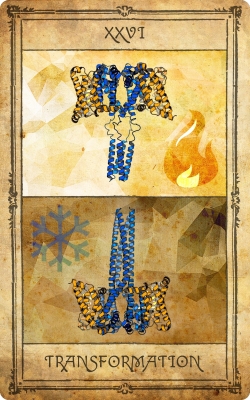 |
Figure: Artistic rendering of a bacterial voltage-gated sodium channel (BacNaVs). The top structure shows a high-temperature unfolded state of the C terminal cytoplasmic domain (CTD), and the bottom structure shows a low-temperature version of the stabilized CTD, where the CTD conformation influences the temperature-dependent response of the channel. |
Dan Minor's group (UCSF) and collaborators asked the question, "How do ion channels sense physical forces?" The best-studied system involves the voltage-sensor domain of a superfamily of voltage-gated ion channels, which serves as a modular element that allows channels to respond to transmembrane voltage changes. Interestingly, many voltage-gated ion channels also respond to temperature. Perception of temperature through changes in ion-channel activity is key to sensing our environment; however, the mechanisms by which channels detect thermal cues have been unclear and there has been a long-standing quest to understand whether, similar to voltage, temperature sensing can be encoded by a discrete protein domain or emerges from a more global property of the channel. By studying the properties of bacterial voltage-gated sodium channels (BacNaVs), the investigators demonstrated that temperature controls BacNaV function via a temperature-dependent unfolding transition of the C terminal cytoplasmic domain (CTD). Structural studies showed that the mechanism is rooted in a bi-partite four-helix bundle with an unusual hydrophilic core, whose integrity is central to the unfolding mechanism. Of major importance, the general four-helix bundle architecture is also present in human voltage-gated ion channels that respond to temperature and are involved in pain sensation. These findings demonstrate that a discrete domain can encode the temperature-dependent response of a channel, define a general principle for ion channel temperature sensor design, and provide a framework for understanding ion channels involved in pain perception.
Citation: Arrigoni, C., Rohaim, A., Shaya, D., Findeisen, F., Stein, R. A., Nurva, S. R., Mishra, S., McHaourab, H. S., and Minor, D. L., Jr. (2016) Unfolding of a Temperature-Sensitive Domain Controls Voltage-Gated Channel Activation, Cell 164, 922-936.